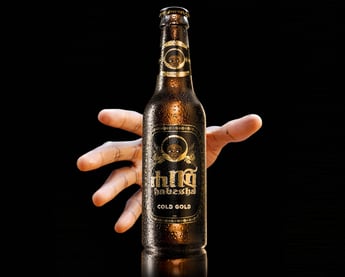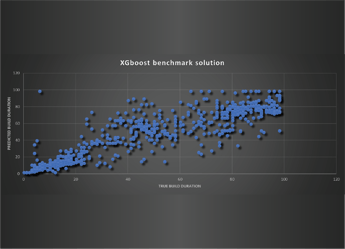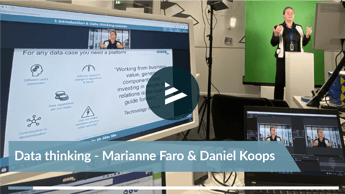Internet of things taken to the sky
Product development firm Oiotos has developed a smart trolley for use in aircrafts. Screvle took care of the IoT hardware, and Itility took care of the software linking the device to the cloud.
We’re all familiar with the trolleys carting food and drink throughout the airplane that we crave for during a flight. These trolleys can get smarter. Searching for an extra meal is cumbersome, anyone can access the trolley when unattended, and a low temperature during the voyage is imperative for reuse of the contents.
If you look at an aircraft as a flying restaurant with guests who can only leave the establishment at a planned time, the potential added value is apparent. A selection tailored to the client and the time of day can generate significantly higher revenue. A more convenient payment terminal would allow for a faster trip along the aisles, possibly allowing for a second tour. Finally, targeted branding in the vicinity of the cart is the icing on the cake.
Oiotos rose to the challenge and launched an IoT project for the development of a smart trolley. It quickly became clear that the challenges would prove more difficult to resolve in real life than expected.
Challenging
The foundation of every IoT project starts with the same rationale. The technical building blocks have been available for some time already. The hardware communicates via software with the cloud where data is made available, this data is interpreted, add a web application to the mix and we’re in business.
In reality, however, challenges arise from the get-go. Mandatory certification requirements prevent the trolley from entering airspace with its new electronic brain and batteries. Moreover, it’s no easy feat to develop hardware with only a modest power and communication budget.
The cloud backend may be the simplest aspect, yet developing the first functional use cases with the client to form a customized in-flight service is challenging. Due to the numerous stakeholders and process owners, the functional dialogue is regularly hampered. It is a matter of searching for the minimum viable product (MVP), and perhaps also for the most viable in-flight business process.
As a result, the playing field demands a broad range of expertise. To this end, Oiotos called upon various parties for assistance: consultancy firm Setelia for front-end consultancy, Itility for the cloud, data science, and software development, and expert club Screvle for the IoT hardware.
Together, we developed the first MVP, complete with access monitoring (when was the trolley opened and closed?), control over the cold chain (monitoring the temperature from the catering kitchen up to the in-flight service, including alerts) and insight into misuse (did the trolley fall off a truck, did someone attempt to force it open?). To achieve this, we integrated sensors for speed, temperature, humidity, and trolley door status.
Scalable
 The development (and production) of the smart, connected device proves to be the most challenging aspect for many IoT applications. Where cloud solutions excel in flexibility and scalability (which enables an agile and rapid approach), we need to take many factors into consideration for the device from the earliest stages of a project. After installation, adjustment of the device is (often) no longer possible – or will result in a costly operation at the very least.
The development (and production) of the smart, connected device proves to be the most challenging aspect for many IoT applications. Where cloud solutions excel in flexibility and scalability (which enables an agile and rapid approach), we need to take many factors into consideration for the device from the earliest stages of a project. After installation, adjustment of the device is (often) no longer possible – or will result in a costly operation at the very least.
On the one hand, we have the technological puzzle that needs to be solved. Consider, for instance, the required lifespan of the battery versus costs and location inside the casing, potential communication networks (taking the target markets and data traffic into consideration), the required casing (waterproof?), certification, and the securing of data traffic. Oiotos was limited, for example, by regulations banning lithium-based batteries in aircrafts; this required additional optimization to attain the required battery life.
On the other hand, the first steps are often tedious due to high initial costs. Economical production for a low unit price often demands high one-off startup costs, such as the purchase of an injection mould for the casing and for the automation of production tests. This influences the device’s ‘economies of scale’, with the unit price for smaller volumes possibly being exponentially higher than that of (later) larger volume productions.
With this in mind, Screvle developed a hardware and software platform to make the development and production of smart, connected electronics more accessible and scalable. Thanks to the company’s building blocks, at least eighty percent of the requirements are available in advance for many IoT applications. This provides more cost-effective and reliable development and an improved time to market.
The software in the smart trolley ensures that information concerning temperature, load, identity, and geographical location are sent to the cloud. The device stores its sensor data on an internal SD card and sends it via a secure connection once its integrated sensor detects Wi-Fi. For an aircraft, this is in the onboard kitchen or on the ground. In the cloud, data is translated to a user interface for the client – this can be in its raw form via an API or via a sophisticated fleet management application, for example. Itility took the lead on this: from drawing intelligence from the data to constructing the software backend and frontend.
Multidisciplinary
Collaboration between the teams is achieved with increasing efficiency. Together, we are getting ever closer to the MVP. The core team receives support from a multitude of players: the trolley manufacturer, the locksmith, the certification body, the caterer and, last but not least, the airline. Once the first pilot trolleys enter an aircraft, we will move from the development phase to the ops phase. This is expected to take place this coming fall, with monitoring of the cold chain as the first use case. Thanks to ideas from the caterer, the product will then rapidly develop further.
This project demonstrates that the development of an IoT system is a multidisciplinary activity which goes much further than building an app to turn on the heating at home. The software engineer, the domain specialist, the businessman, the hardware developer, and the data scientist will have to put their heads together. The process on top of the technical building blocks is distinctly people-driven.






